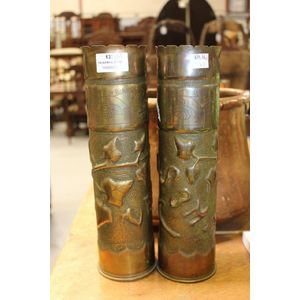Japanese Lacquer Inro Set with Netsuke and Ojime
You must be a subscriber, and be logged in to view price and dealer details.
Subscribe Now to view actual auction price for this item
When you subscribe, you have the option of setting the currency in which to display prices to $Au, $US, $NZ or Stg.
- Lacquered Lacquerware - Lacquer is a clear or coloured resin that is obtained from the sap of several species of trees in the genus Rhus, particularly the Rhus verniciflua tree, which is native to China and Japan. The resin is harvested by making incisions in the tree bark and collecting the sap that oozes out.
The sap is then processed and refined through a series of steps, which may include filtration, heating, and chemical treatments. The resulting lacquer is a highly durable and glossy material that is used as a finish for furniture, musical instruments, and other objects.
Lacquer has been used for thousands of years in Asia, where it is valued for its beauty and durability. It is applied in multiple thin layers, with each layer being allowed to dry and harden before the next one is added. The process can take several weeks or even months to complete, but the resulting finish is incredibly hard, glossy, and resistant to scratches and wear.
The lacquer derived from the resin of the Rhus tree has been used for decoration of furniture in several countries in Asia, particularly China, Japan, Korea, and Vietnam. These countries have rich traditions of using lacquer for furniture decoration and have developed unique techniques and styles of lacquer work.
In China, lacquer has been used for furniture decoration for over 2,000 years, and it became a major art form during the Ming (1368-1644) and Qing (1644-1912) dynasties. Chinese lacquerware is known for its intricate carving, painting, and inlay work, as well as its use of bold colours and designs. Lacquer was used to decorate furniture such as cabinets, screens, and chairs.
In Japan, lacquer has been used for furniture decoration for over 1,000 years. Japanese lacquerware is characterized by its simplicity and elegance, and it often incorporates natural materials such as wood, bamboo, and shells. Lacquer was used to decorate furniture such as chests, cabinets, and trays.
In Korea, lacquer has been used for furniture decoration for over a thousand years. Korean lacquerware is known for its restrained and understated beauty, and it often features delicate patterns and designs that are achieved through careful layering and carving. Lacquer was used to decorate furniture such as cabinets, chests, and screens.
In Vietnam, lacquer has been used for furniture decoration for over 2,000 years. Vietnamese lacquerware is known for its vibrant colours and intricate designs, and it often features scenes from daily life, nature, and mythology - Ojime - An ojime is a small decorative bead that is used as a sliding bead or toggle on the cord of a traditional Japanese netsuke. The netsuke is a small sculptural object that was used to fasten a container, such as a box or pouch, to the obi (sash) worn with a traditional Japanese kimono.
The ojime was used to adjust the length of the cord or to secure the container in place. Ojime beads were typically made from a variety of materials such as wood, ivory, bone, and stone. They were often elaborately carved with intricate designs or decorated with colourful lacquer, enamel, or inlay work.
This item has been included into following indexes:
Visually similar items

Pair of World War I French brass trench art vases with VERDUN and SOMME in relief and floral decoration, approx 30 cm high (2)

Two Chinese wooden Brushpots. Each carved with scholars engaged in leisurely pursuits, including games of 'Go' and drinking tea in bamboo groves and under pine trees, each with a tripod base, 18.5 cm high

Doulton Lambeth and silver mounted wine jug and two matching beakers. Maker George Tinworth. 25 cm high.

Two Sterling silver perfume bottles one with glass liner missing, H5.5 cm approx
